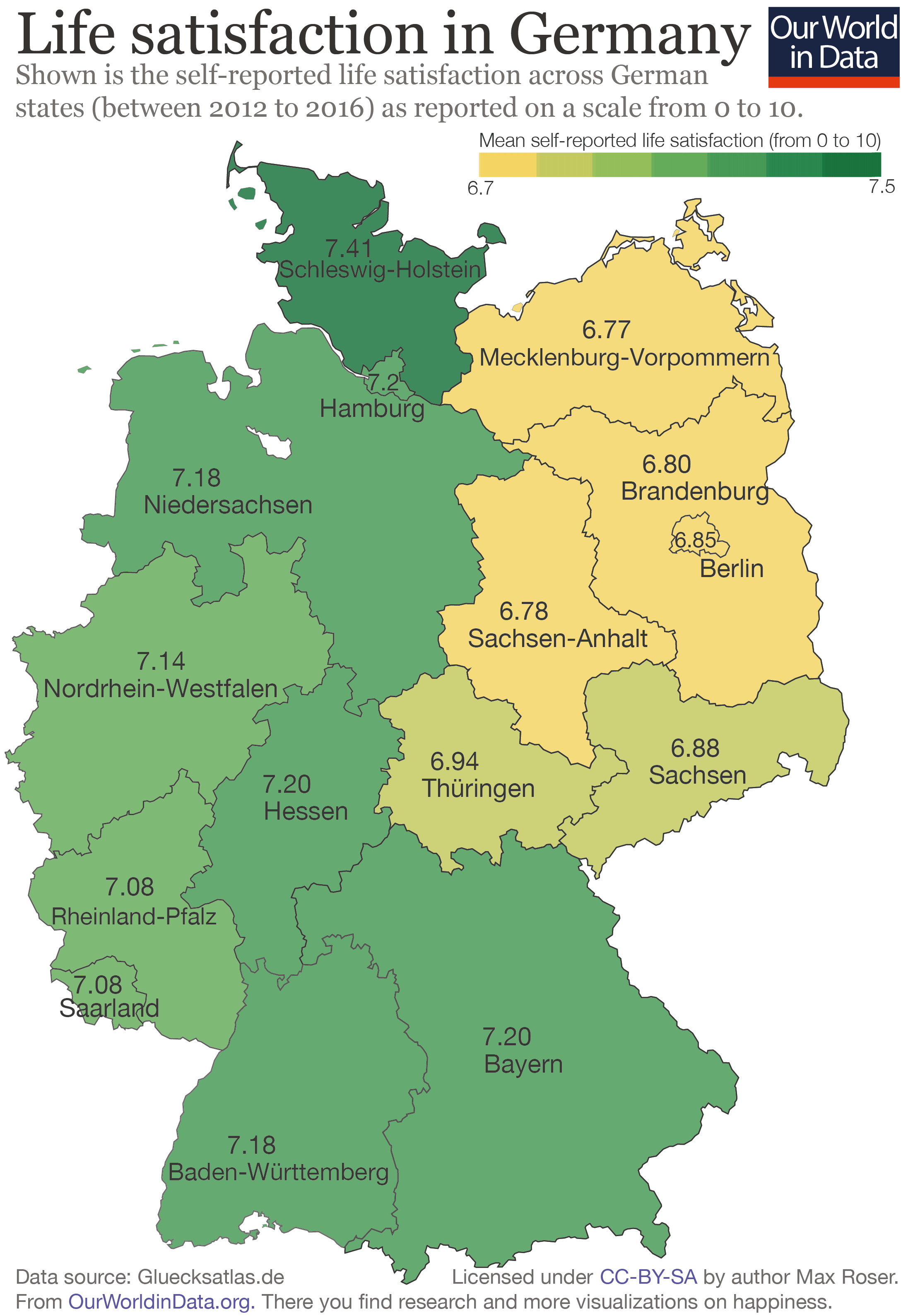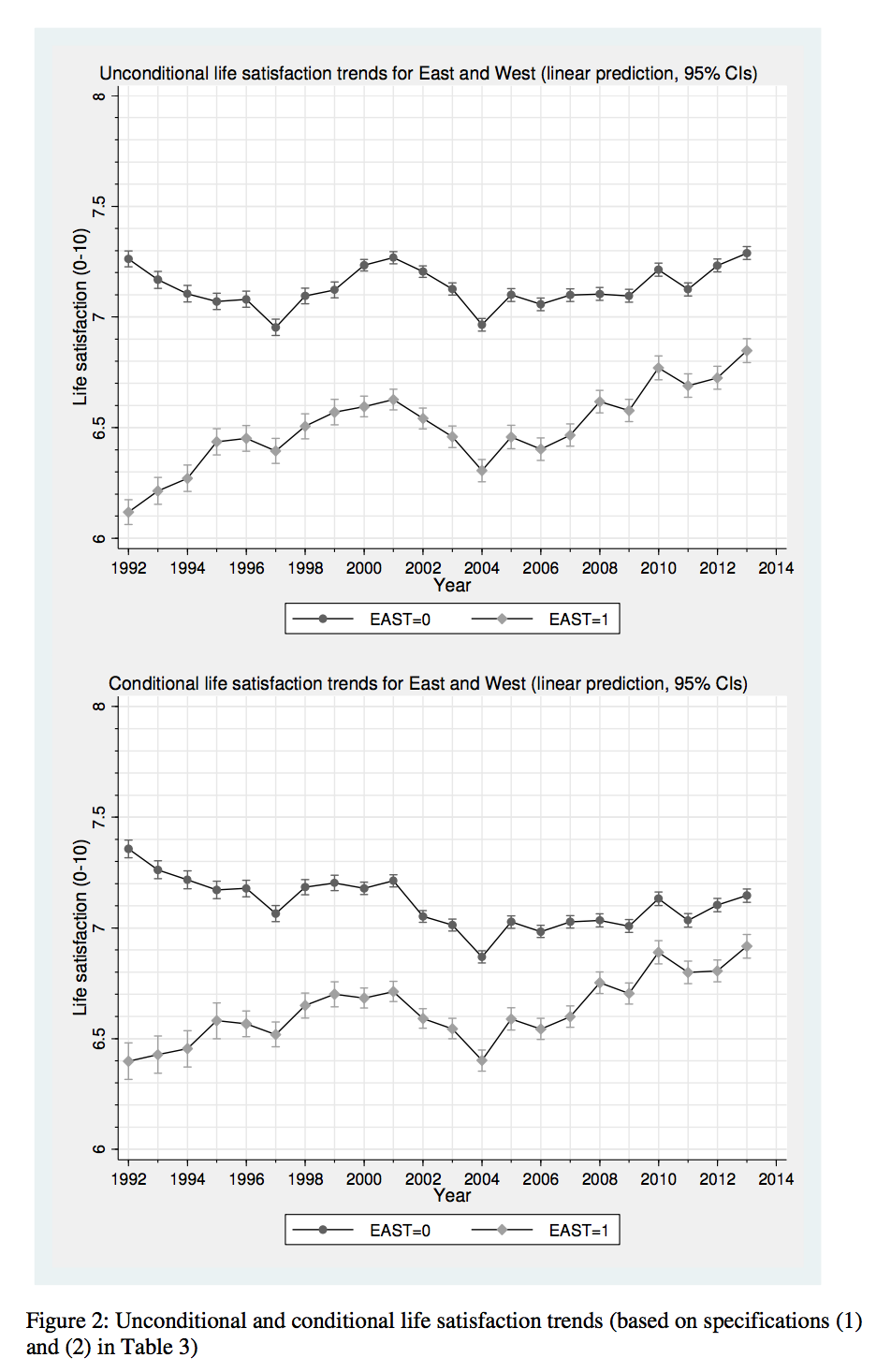There is a 'happiness gap' between East and West Germany
In global surveys of happiness and life satisfaction, Germany usually ranks high. However, these national averages mask large inequalities. In the map shown we focus on regional inequalities—specifically the gap in life satisfaction between West and East Germany.
This map plots self-reported life satisfaction in Germany (using the 0-10 Cantril Ladder question), aggregating averages scores at the level of Federal States.1 What stands out is a clear divide between the East and the West, along the political division that existed before the reunification of Germany in 1990.

For example, the difference in levels between neighboring Schleswig-Holstein (in West Germany) and Mecklenburg-Vorpommern (in East Germany) are similar to the difference between Sweden and the US – a considerable contrast in self-reported life satisfaction.
Several academic studies have looked more closely at this 'happiness gap' in Germany using data from more detailed surveys, such as the German Socio-Economic Panel (e.g. Petrunyk and Pfeifer 2016).2 These studies provide two main insights:
First, the gap is partly driven by differences in household income and employment. But this is not the only aspect; even after controlling for socioeconomic and demographic differences, the East-West gap remains significant.
Germany's happiness gap over time
And second, the gap has been narrowing in recent years, as the chart shows. In fact, the finding that the gap is narrowing is true both for the raw average differences, as well as for the 'conditional differences' (i.e. the differences that are estimated after controlling for socioeconomic and demographic characteristics).

The observation that socioeconomic and demographic differences do not fully predict the observed East-West differences in self-reported happiness is related to a broader empirical phenomenon: Culture and history matter for self-reported life satisfaction—and in particular, ex-communist countries tend to have a lower subjective well-being than other countries with comparable levels of economic development.
Endnotes
In some cases, the underlying data had multiple average estimates for the same territory (e.g. Baden and Württemberg were treated as different entities). In these cases the map shows the average between these two observations. Details can be found in this file
Petrunyk, I., & Pfeifer, C. (2016). Life satisfaction in Germany after reunification: Additional insights on the pattern of convergence. Jahrbücher für Nationalökonomie und Statistik, 236(2), 217-239.
Cite this work
Our articles and data visualizations rely on work from many different people and organizations. When citing this article, please also cite the underlying data sources. This article can be cited as:
Esteban Ortiz-Ospina (2017) - “There is a 'happiness gap' between East and West Germany” Published online at OurWorldInData.org. Retrieved from: 'https://ourworldindata.org/there-is-a-happiness-gap-between-east-and-west-germany' [Online Resource]BibTeX citation
@article{owid-there-is-a-happiness-gap-between-east-and-west-germany,
author = {Esteban Ortiz-Ospina},
title = {There is a 'happiness gap' between East and West Germany},
journal = {Our World in Data},
year = {2017},
note = {https://ourworldindata.org/there-is-a-happiness-gap-between-east-and-west-germany}
}Reuse this work freely
All visualizations, data, and code produced by Our World in Data are completely open access under the Creative Commons BY license. You have the permission to use, distribute, and reproduce these in any medium, provided the source and authors are credited.
The data produced by third parties and made available by Our World in Data is subject to the license terms from the original third-party authors. We will always indicate the original source of the data in our documentation, so you should always check the license of any such third-party data before use and redistribution.
All of our charts can be embedded in any site.

